Planning your own trip? Prepare for your trip
Use Rough Guides' trusted partners for great rates
Plan and book your private, tailor-made tour with vetted local experts
Monsanto has been proudly calling itself Portugal’s most Portuguese village since winning the title back in 1948 – and it’s not giving it up anytime soon. Perched high on a granite hill above the plains, it’s a jumble of stone houses squeezed between colossal boulders, with some walls and roofs formed entirely from rock. One, the Casa de Uma Só Telha, is topped by a single slab of granite so huge it’s almost hard to believe. Life here is quiet: a couple of cafés, a small grocer, and the odd gift shop catering to Spanish day-trippers. But stay the night and you’ll see a different side – the glow of lamplight on cobblestones, the soft clang of goat bells, and the kind of stillness you rarely find these days. From the ruined Templar castle at the summit, views roll out for miles, and every winding alley seems to hide another reason to linger just a little longer.

Hey, I’m Joel, your Portugal travel expert, and I’ve been exploring Portuguese villages for years, but Monsanto is in a league of its own. Sitting on a granite ridge with views stretching across the Beira Baixa plains, it’s a place where homes grow out of the rock itself and alleyways seem designed to make you lose track of time. This Monsanto travel guide will give you the essentials: getting there, what’s worth your attention, and where you can bed down for the night. Monsanto is best taken at a slow pace. Wander until you find yourself beneath a house roofed by a single boulder, pause for a coffee in the tiny square, and let the climb to the old Templar castle reward you with a horizon of rolling hills. The big draws are easy to spot: Casa de Uma Só Telha, the castle ruins, the medieval churches, but it’s often the little things that stay with you: a hand-painted doorway, a neighbor offering you a fig, the smell of woodsmoke curling through the lanes.
Joel’s tip
Walk up to the castle in the late afternoon. The heat will have eased, the day-trippers will be gone, and you’ll have the views and the silence, almost to yourself.
Best time to visit
Spring (April-June) and autumn (September-October) are ideal with warm days, clear skies, and fewer visitors. July and August can be hot, and shade is in short supply. Winter is cooler and quieter, perfect if you want the narrow streets all to yourself.
How to get to Monsanto
The nearest train station is in Castelo Branco, about 26 km away, with services from Lisbon and Porto. From there, you can take a taxi or local bus to the village. Driving is the easiest option, it’s roughly 3 hours from Lisbon or 2 hours from Porto, and you’ll have more freedom to explore the surrounding countryside.
Best areas to stay in Monsanto
Monsanto lies in central Portugal’s Beira Baixa region, perched high on a granite hill not far from the Spanish border. It’s approximately 26 km from Castelo Branco and a three-hour drive from Lisbon.
Often listed among the best places to visit in Portugal, this historic hilltop village is a memorable stop on any Portugal itinerary. From here, you can wander to the nearby Roman ruins of Idanha-a-Velha, explore the hiking trails in the Serra da Malcata Natural Reserve, or hop across the border for a day in western Spain.


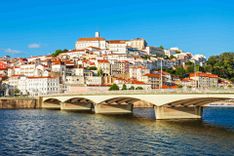
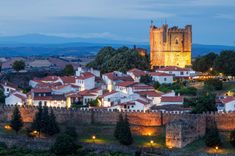

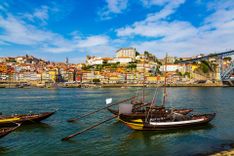










Monsanto is tiny, steep, and made for walking. There’s no public transport inside the village; the narrow cobbled lanes are only passable on foot, but that’s part of the charm. You’ll be stopping often anyway, to catch your breath on the climb or to admire a view framed by granite boulders.
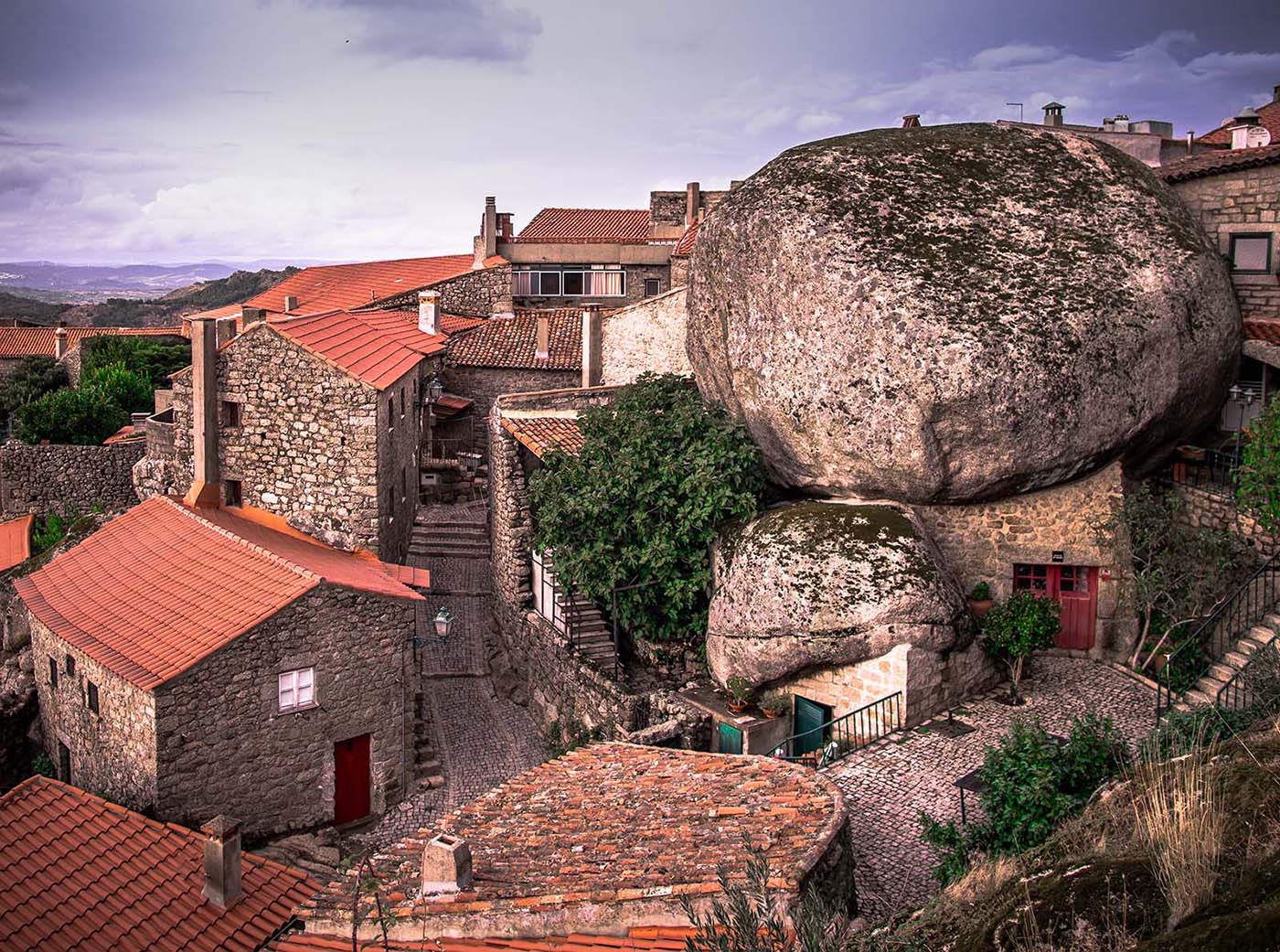
Monsanto with it's massive stone boulder houses © Shutterstock
If you’re asking how many days in Monsanto are enough, a single full day will let you see the main sights without rushing: the Templar castle, Casa de Uma Só Telha, the São Salvador Church, and the best viewpoints over the plains. But if you can, stay overnight. Once the day-trippers leave, the village feels different, quieter, more atmospheric, and perfect for a slow wander through its lamp-lit lanes.
If you’re planning a 10-day itinerary in Portugal that includes central Portugal, consider giving Monsanto two days. Spend one exploring the village itself, then use the other for nearby trips: the Roman ruins at Idanha-a-Velha, the medieval streets of Penha Garcia, or hiking trails in the Serra da Malcata Natural Reserve. An extra night also means you can catch both sunset and sunrise from the castle walls, which is reason enough to linger.
Monsanto has a handful of small guesthouses and rural stays, most tucked into stone houses within or just outside the village walls. Here’s where to base yourself depending on how you like to travel.

Monsanto Castle Ruins - Portugal © Shutterstock
Monsanto is small enough to explore in a day, but its mix of medieval history, granite-carved architecture, and sweeping countryside views means there’s plenty to keep you staying a while. Here’s the in-depth list of the best things to do in Monsanto, each one worth slowing down for.
The ruins of Monsanto’s castle crown the highest point of the granite hill, a short but steep climb from the village square. Built in the 12th century by the Knights Templar, the fortress guarded this strategic border region for centuries. Although time and earthquakes have reduced it to crumbling walls, it still commands one of the most spectacular views in Portugal: on a clear day, you can see into Spain.
Inside, you’ll find fragments of towers, worn battlements, and traces of medieval storage rooms. There are no barriers, so watch your footing on uneven stones. Bring water and a hat in summer, the climb is exposed, and try to come at sunrise or sunset, when the golden light makes the granite glow and the village below falls into shadow.
In a village famous for building houses into boulders, Casa de Uma Só Telha still manages to surprise. Its name, “House of One Tile,” refers to the roof, which is a single massive granite slab, weighing many tons. It’s an ingenious example of how Monsanto’s builders adapted to their environment rather than fighting it.
While you can’t go inside, the house is easy to spot on a short loop through the village and makes for a striking photograph. Stand back to see how seamlessly the stone integrates with the rest of the building, and notice how other nearby homes are also built into, under, or even on top of the natural rock. The best time to visit is late afternoon, when the sun throws the stone into sharp relief and the crowds have thinned.
Just below the castle path, the 12th-century São Salvador Church offers a peaceful pause before you tackle the final climb. Its Romanesque design is simple: thick walls, small windows, and a plain but elegant arched doorway, yet it has stood here for more than 800 years, surviving storms, wars, and the slow decay of time. Inside, the cool air carries the faint scent of old stone, and you’ll find carved capitals, modest altar decorations, and centuries of wear on the floor slabs.
The church is often empty, so you may have it to yourself. Take a moment to step outside and look back towards the village; the view of red rooftops framed by boulders is one of the prettiest in Monsanto.
Monsanto’s geography means every bend in the lane offers a potential miradouro, but there are a few you shouldn’t miss. The terrace near the Lucano Tower opens onto a vast sweep of plains, fields, and distant hills. From the castle walls, you get a 360° panorama that includes the Serra da Estrela mountains to the northwest and the borderlands of Spain to the east.
On clear winter days, you might even spot snow on the high peaks. Morning light is best for views eastwards into Spain, while evenings are ideal for west-facing vistas as the plains turn gold. Pack binoculars if you’re a birdwatcher, eagles and kestrels often ride the thermals above the cliffs.
The best way to experience Monsanto is to surrender to its layout. Narrow stone lanes loop and climb unpredictably between houses built into giant granite boulders, each turn revealing a new angle on the village. Some walls are so closely fitted to the rock that it’s hard to tell where nature ends and construction begins.
Look for hand-carved door lintels marked with dates, tiny chapels tucked between houses, and the communal bread ovens that still hint at a slower, more communal way of life. Along the way, you’ll pass cats napping on warm stones, neighbors chatting from doorways, and the occasional rooster crowing in the distance.
Built in the 18th century, this slender bell tower rises above the rooftops and serves as a proud emblem of the village. It’s topped with a silver rooster, awarded when Monsanto won the 1948 “Most Portuguese Village” contest, a title it still promotes today. You can’t climb inside, but the base of the tower sits in one of the liveliest small squares, making it a natural gathering place.
From here, you can easily branch off into side streets that lead either up to the castle or down to quieter residential lanes. If you come in the evening, you might catch the sound of bells echoing off the surrounding granite cliffs.
Food in Monsanto is simple but deeply rooted in local traditions. Many small taverns, or tascas, serve queijo da Beira Baixa: a creamy sheep’s cheese, alongside honey, crusty bread, and smoked sausages like chouriço or farinheira. Game meats, such as wild boar stew, appear in colder months. Portions are hearty, and the wine list often includes reds from the nearby Beira Interior region.
It’s worth booking ahead if you’re visiting in the evening, as some restaurants close early or only serve lunch. Don’t rush the meal; the slow pace is part of the experience, and the owners are usually happy to share stories about the village.
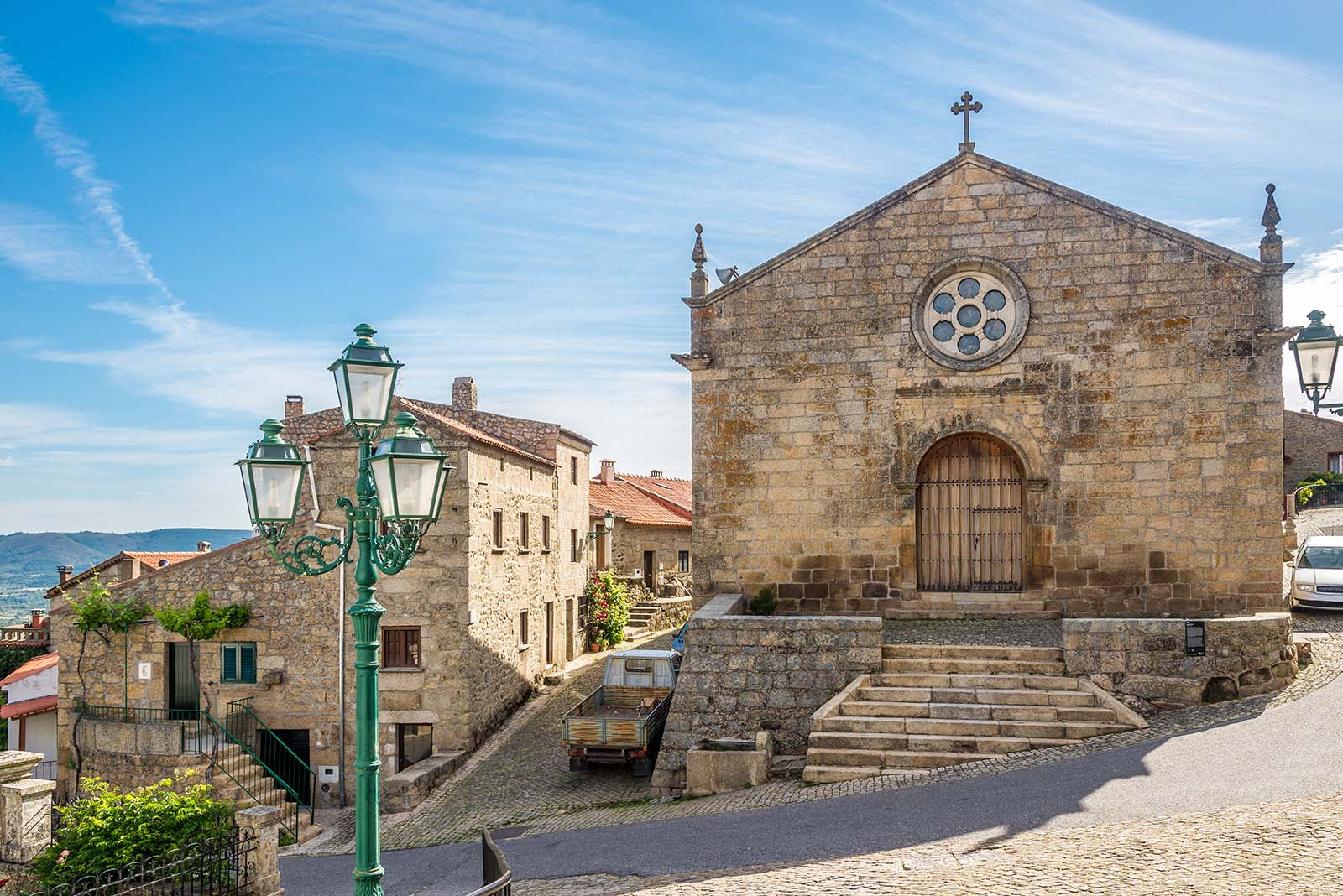
Church Matriz of Sao Salvador in the streets of Monsanto in Portugal © Shutterstock
A short drive from Monsanto lies Idanha-a-Velha, one of Portugal’s most important archaeological sites. Once a bustling Roman city known as Egitânia, it later became a Visigothic and medieval settlement. Today, the remains include sections of ancient walls, the ruins of a basilica, a Visigothic church, and dozens of inscribed stone slabs on display in the open air.
The village is tiny and quiet, so it’s easy to wander at your own pace, imagining the layers of history beneath your feet. Combine it with a morning in Monsanto for a history-rich day trip, or linger and have lunch in one of the local cafés before heading back up the hill.
Just 20 minutes from Monsanto, Penha Garcia combines medieval heritage with geology. A short circular trail takes you past the ruins of a hilltop castle and into a gorge where fossilized marine creatures are embedded in the rock, reminders that this was once a seabed hundreds of millions of years ago.
Along the way, you’ll see restored watermills, small waterfalls, and, in summer, the inviting waters of a natural river pool. It’s a family-friendly walk, but parts are uneven, so trainers or hiking shoes are recommended. Information panels in English explain the fossils and mill workings, making it both scenic and educational.
If you have an extra day, head about an hour east to the Serra da Malcata, one of Portugal’s last wild strongholds. Known as a former habitat of the critically endangered Iberian lynx, it’s now a protected area for eagles, deer, and wild boar. Trails wind through cork oak forests and open meadows, offering far-reaching views and a sense of real remoteness.
There are no facilities inside the reserve, so bring food, water, and a map. Spring brings wildflowers and cooler weather, while autumn offers warm, golden light and fewer visitors. It’s a complete contrast to the compact stone lanes of Monsanto, wide open and untamed.
Monsanto has a Mediterranean climate with continental influence, meaning warm, dry summers, mild but wetter winters, and bigger day-to-night temperature swings than coastal cities like Lisbon. The best time to visit Portugal’s most famous hilltop village depends on how you like to travel. Perched 758 meters above sea level, Monsanto stays cooler in summer than the lowlands, but winter mornings can be crisp. Average temperatures range from around 45°F (7°C) in January to 84°F (29°C) in August, though heatwaves can push it higher and cold snaps can make nights near freezing in winter. For current conditions, check IPMA (Portuguese Institute for Sea and Atmosphere).

Carved and inscribed Roman stones. Idanha-a-Velha. Portugal © Shutterstock
Monsanto’s dining scene is small but full of character. Most places are family-run, set in granite houses, and serve traditional Beira Baixa flavors that match the village’s rugged charm. Expect hearty meat stews, mountain cheeses, and bread baked in wood-fired ovens. Menus are short, ingredients are local, and portions are generous, exactly what you need after tackling the castle climb.
Here are some unique experiences we can arrange for your tailor-made Monsanto trip: all private, flexible, and designed by our local travel experts.
Discover Portugal's most captivating stories
Use Rough Guides' trusted partners for great rates
written by
Olga Sitnitsa
Online editor at Rough Guides, specialising in travel content. Passionate about creating compelling stories and inspiring others to explore the world.